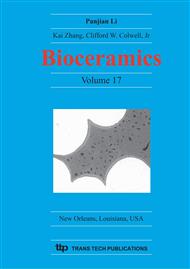p.531
p.537
p.541
p.545
p.549
p.553
p.557
p.561
p.565
Osteoclast Response of Biomimetically Processed Silica and Carbonate Containing Calcium Phosphate Layers on Bioactive Glass S53P4
Abstract:
Different silica and carbonate containing calcium phosphate (CaP) layers were prepared on bioactive glass S53P4 in conventional C-SBF and revised R-SBF. In R-SBF the CaP layer formed faster compared to C-SBF, and the CaP layer formed in R-SBF was amorphous compared to the poorly crystalline bonelike HCA formed in C-SBF. In addition, the influence of chemical composition, dissolution and structure of biomimetically processed CaP layers on osteoclast and osteoblast activity was studied. In general, biomimetic CaP layers on bioactive glass S53P4 did not affect so much on bone cell activity as it was expected compared to the untreated glass. Additionally, it was observed that the mechanism for good osteoclast activity is multifactorial. The optimal surface for osteoclast adhesion and growth was an amorphous CaP having mesoporous nanotopography and proper dissolution rate of calcium and silica. Also osteoblasts grew well on such surface.
Info:
Periodical:
Pages:
549-552
Citation:
Online since:
April 2005
Keywords:
Price:
Сopyright:
© 2005 Trans Tech Publications Ltd. All Rights Reserved
Share:
Citation:


